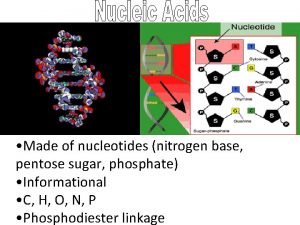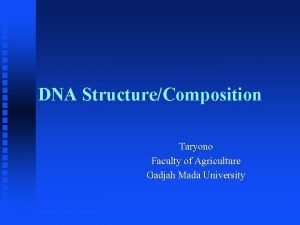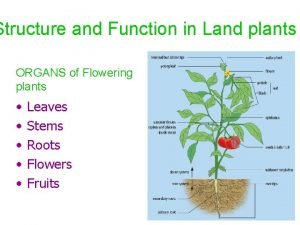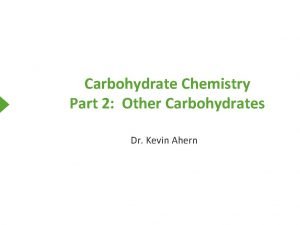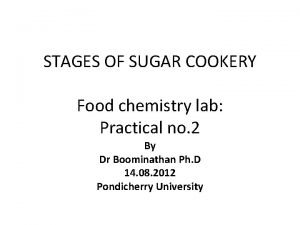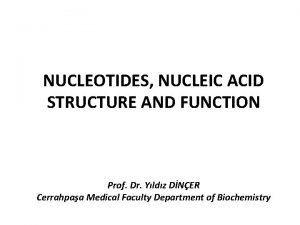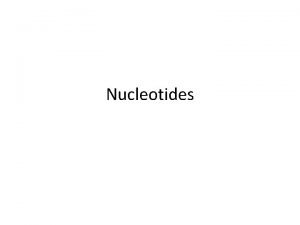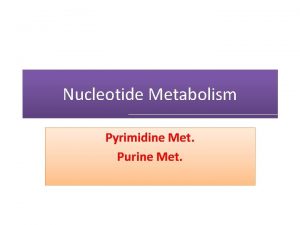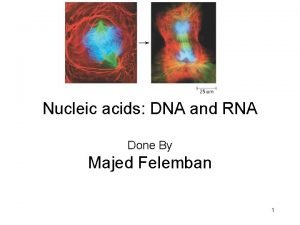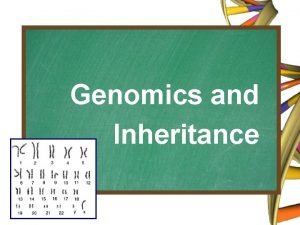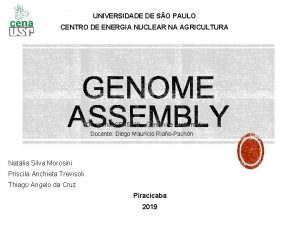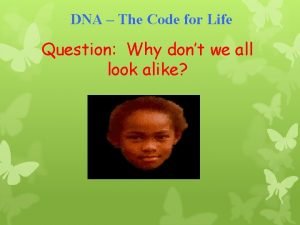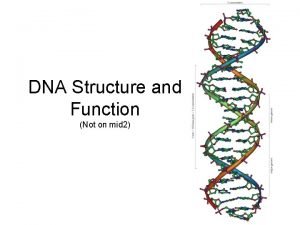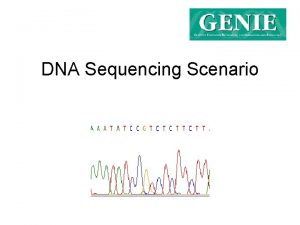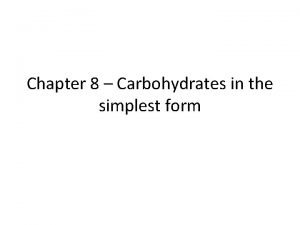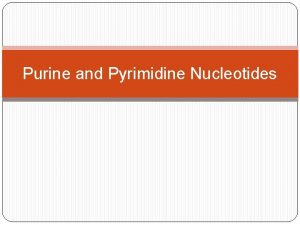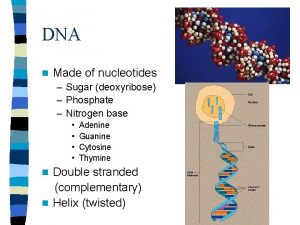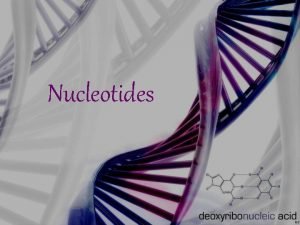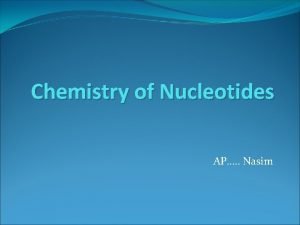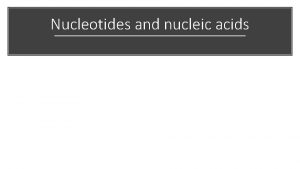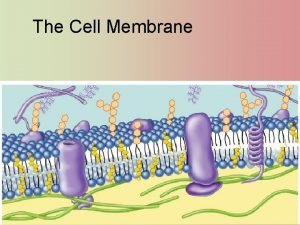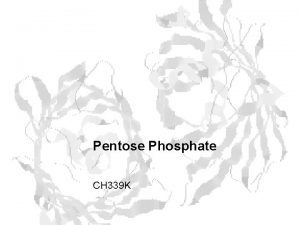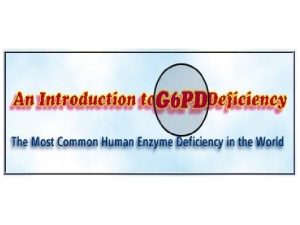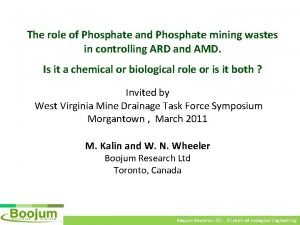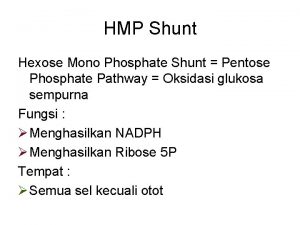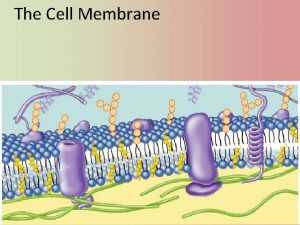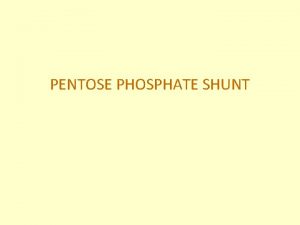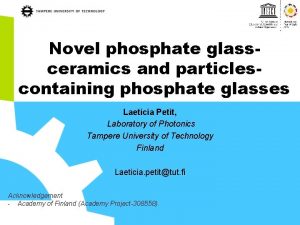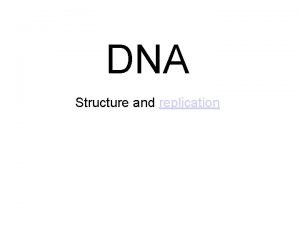Key Concepts Nucleotides consist of a sugar phosphate




















- Slides: 20

Key Concepts Nucleotides consist of a sugar, phosphate group, and nitrogencontaining base. Ribonucleotides polymerize to form RNA. Deoxyribonucleotides polymerize to form DNA’s primary structure consists of a sequence of nitrogencontaining bases; its secondary structure consists of two DNA strands running in opposite directions, held together by complementary base pairing, and twisted into a double helix. DNA’s structure allows organisms to store and replicate the information needed to grow and reproduce. © 2011 Pearson Education, Inc.

Key Concepts RNA’s primary structure consists of a sequence of nitrogen-containing bases. Its secondary structure includes short regions of double helices and structures called hairpins. RNA was likely the first self-replicating molecule and a forerunner to the first life-form. Know the following scientists’ contributions to DNA’ discovery: 1. Frederick Griffith - transformation 2. Avery, Mc. Carty, Mac. Leod – DNA as the genetic material 3. Alfred Hershey & Martha Chase – DNA as the genetic material 4. Linus Pauling – Protein structure & helical shape 5. Erwin Chargaff – correct base pairing 6. Maurice Wilkins & Rosalind Franklin – confirmed helical shape 7. Watson & Crick – overall shape of DNA 8. Meselson & Stahl – DNA replication © 2011 Pearson Education, Inc.

What Is a Nucleic Acid? • A nucleic acid is a polymer of nucleotide monomers. • Nucleotides are each composed of a phosphate group, a sugar, and a nitrogenous base. – The sugar is ribose in ribonucleotides and deoxyribose in deoxyribonucleotides. • There are two groups of nitrogenous bases: – purines (adenine, guanine) – pyrimidines (cytosine, uracil, and thymine) • Uracil (U) is found only in ribonucleotides, and thymine (T) is found only in deoxyribonucleotides. © 2011 Pearson Education, Inc.

© 2011 Pearson Education, Inc.

Could Chemical Evolution Produce Nucleotides? • Simulations of chemical evolution have not yet produced nucleotides. • Sugars and purines are easily made, but pyrimidines and ribose are not easily synthesized. • Ribose problem: Ribose would have had to have been dominant on ancient Earth for nucleic acids to form. © 2011 Pearson Education, Inc.

Nucleotides Polymerize to Form Nucleic Acids Nucleic acids form when nucleotides polymerize. • A condensation reaction forms a phosphodiester linkage (phosphodiester bond) between the phosphate group on the 5′ carbon of one nucleotide and the –OH group on the 3′ carbon of another. • Types of nucleotides involved: 1. Ribonucleotides, which contain the sugar ribose and form RNA 2. Deoxyribonucleotides, which contain the sugar deoxyribose and form DNA © 2011 Pearson Education, Inc.

© 2011 Pearson Education, Inc.

The Sugar-Phosphate Backbone Is Directional • The sugar-phosphate backbone of a nucleic acid is directional—one end has a 5′ carbon, and the other end has a 3′ carbon. • The nucleotide sequence is written in the 5′ 3′ direction. This reflects the sequence in which nucleotides are added to a growing molecule. • This nucleotide sequence comprises the nucleic acid’s primary structure. © 2011 Pearson Education, Inc.

The Polymerization of Nucleic Acids Is Endergonic • Polymerization of nucleic acids is an endergonic process catalyzed by enzymes. • Energy for polymerization comes from the phosphorylation of the nucleotides. – Phosphorylation is the transfer of one or more phosphate groups to a substrate molecule. This raises the potential energy of the substrate and enables endergonic reactions. • In nucleic acid polymerization, two phosphates are transferred, creating a nucleoside triphosphate. © 2011 Pearson Education, Inc.

© 2011 Pearson Education, Inc.

What Is the Nature of DNA's Secondary Structure? • Erwin Chargaff established two empirical rules for DNA: 1. The total number of purines and pyrimidines is the same. 2. The numbers of A’s and T’s are equal and the numbers of C’s and G’s are equal. © 2011 Pearson Education, Inc.

Watson and Crick’s Model of DNA’s Secondary Structure • James Watson and Francis Crick determined: 1. DNA strands run in an antiparallel configuration. 2. DNA strands form a double helix. – The hydrophilic sugar-phosphate backbone faces the exterior. – Nitrogenous base pairs face the interior. 3. Purines always pair with pyrimidines. – Specifically, strands form complementary base pairs AT and G-C. – A-T have two hydrogen bonds. – C-G have three hydrogen bonds. 4. DNA has two different sized grooves: the major groove and the minor groove. © 2011 Pearson Education, Inc.

© 2011 Pearson Education, Inc.

Summary of DNA’s Secondary Structure • DNA’s secondary structure consists of two antiparallel strands twisted into a double helix. The molecule is stabilized by hydrophobic interactions in its interior and by hydrogen bonding between the complementary base pairs A-T and G-C. © 2011 Pearson Education, Inc.

DNA Contains Biological Information • DNA can store and transmit biological information. • The language of nucleic acids is contained in the sequence of the bases. • DNA carries the information required for the growth and reproduction of all cells. © 2011 Pearson Education, Inc.

RNA Structure and Function • Like DNA, RNA has a primary structure consisting of a sugarphosphate backbone formed by phosphodiester linkages and, extending from that backbone, a sequence of four types of nitrogenous bases. • The primary structure of RNA differs from DNA in two ways: 1. RNA contains uracil instead of thymine. 2. RNA contains ribose instead of deoxyribose. – The presence of the –OH group on ribose makes RNA much more reactive and less stable than DNA. © 2011 Pearson Education, Inc.

RNA’s Secondary Structure • RNA’s secondary structure results from complementary base pairing. • The bases of RNA typically form hydrogen bonds with complementary bases on the same strand. • The RNA strand folds over, forming a hairpin structure: the bases on one side of the fold align with an antiparallel RNA segment on the other side of the fold. • RNA molecules can have tertiary and quaternary structures. © 2011 Pearson Education, Inc.

© 2011 Pearson Education, Inc.

RNA’s Versatility • RNA is structurally, chemically, and functionally intermediate between DNA and proteins. RNA, due to its single-strandedness, is more reactive than DNA. • Like DNA, RNA can function as an information-containing molecule, and is capable of self-replication. • RNA can function as a catalytic molecule. – Ribozymes are enzyme-like RNAs. © 2011 Pearson Education, Inc.

The First Life-Form: RNA can both provide a template for copying itself and catalyze the polymerization reactions that would link monomers into a copy of that template. Thus, most origin-of-life researchers propose that the first life-form was made of RNA. • RNA is not very stable, but might have survived long enough in the prebiotic soup to replicate itself, becoming the first life-form. • Researchers found that a ribozyme called RNA replicase could be isolated that could catalyze the addition of ribonucleotides to a complementary RNA strand. © 2011 Pearson Education, Inc.
 Sugar phosphate and nitrogenous base
Sugar phosphate and nitrogenous base Sugar phosphate backbone of dna
Sugar phosphate backbone of dna Sugar source vs sugar sink
Sugar source vs sugar sink Tracheids and vessels difference
Tracheids and vessels difference Non reducing sugar vs reducing sugar
Non reducing sugar vs reducing sugar Stages of sugar cooking
Stages of sugar cooking Glucose seliwanoff test
Glucose seliwanoff test Nucleotides
Nucleotides Alloburinol
Alloburinol Two purine bases
Two purine bases Nucleotide sequence vs amino acid sequence
Nucleotide sequence vs amino acid sequence Four nucleotides of dna
Four nucleotides of dna Order of nucleotides in dna
Order of nucleotides in dna Nucleotides wiki
Nucleotides wiki Dna rna
Dna rna When dna untwists, unzips, and nucleotides fill in.
When dna untwists, unzips, and nucleotides fill in. Functions of nucleotides
Functions of nucleotides Ddntp et dntp
Ddntp et dntp Secret code
Secret code Simplest form of carbohydrates
Simplest form of carbohydrates Which key activities do partners perform
Which key activities do partners perform
